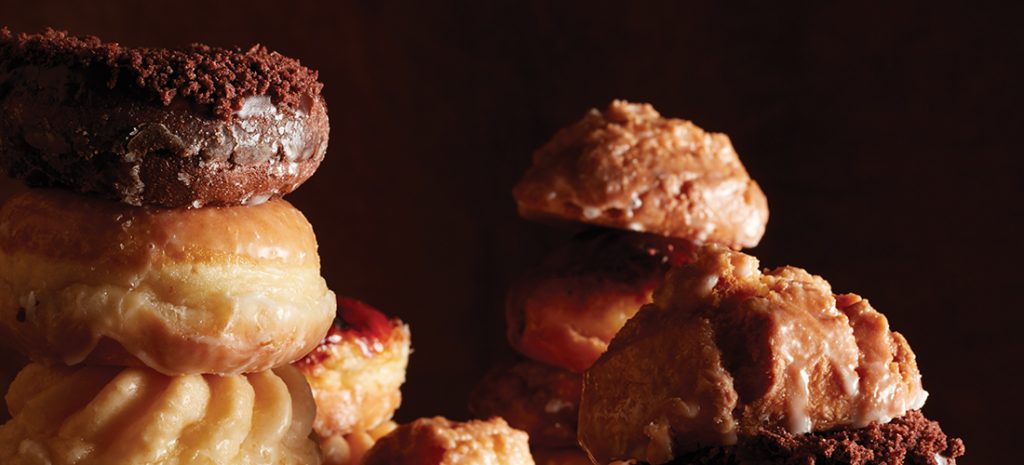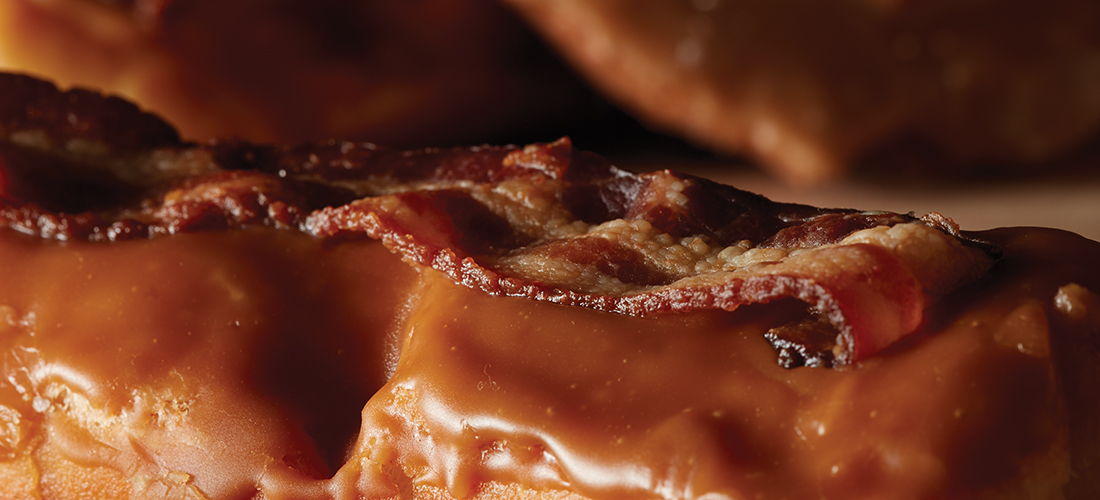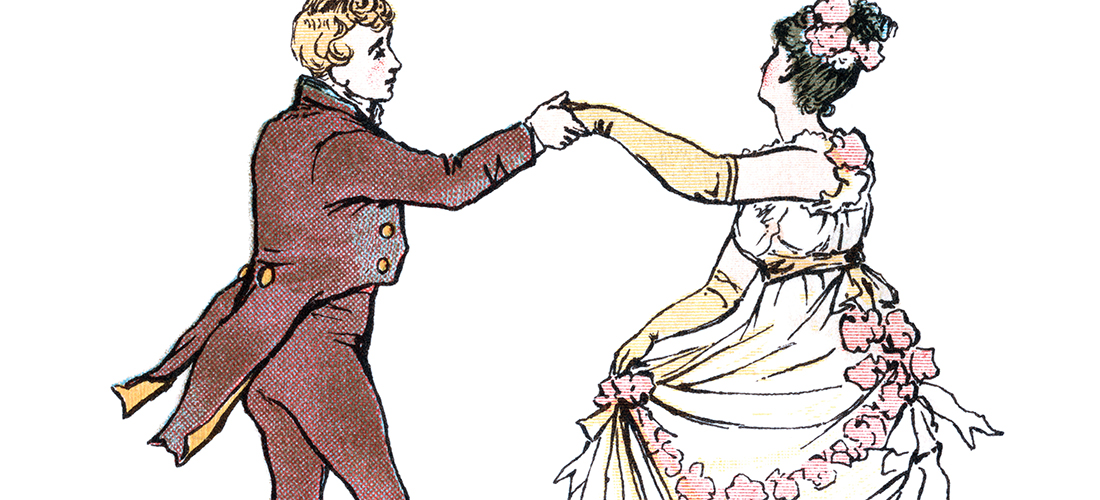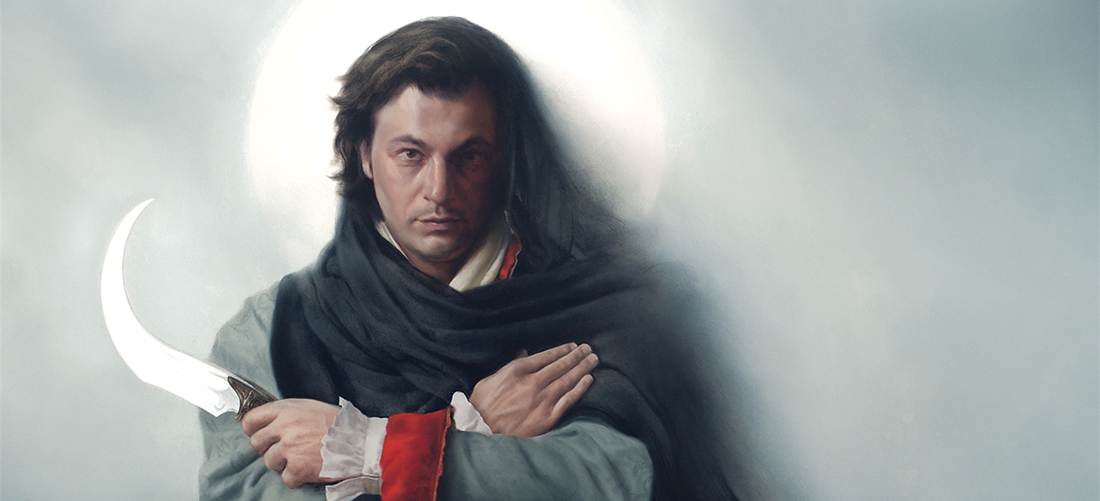Doughnut Central
Don’t look now, but, the Gate City is on its way to becoming Greensbordough
By Annie Ferguson • Photographs by Mark Wagoner
The second coming of Dunkin’ Donuts to the South was well-timed in my little corner of Greensboro. The year was 2008, and less than a mile from my office — where I was working on United Airlines’ inflight magazine with a talented — and doughnut-obsessed — group of editors, I could suddenly find a Double Chocolate doughnut. What?! I hadn’t had one so easily accessible since childhood, when family and friends would convene at the Dunkin’ Donuts in Salisbury after Sunday Mass. What’s more, I was pregnant. If anyone was more deserving of a serving of Dunkin’ Donuts in the land of Krispy Kreme, it was me. After all, I was eating for two. My fellow editors acknowledged my, er, delicate condition by occasionally delivering my favorites right to my desk.
But the coming of Dunkin’ Donuts was just a foreshadowing of what became a veritable donut renaissance. Forget the multinational chains with their big-buck advertising campaigns. It was small, enterprising family-owned businesses that turned Greensboro into a mecca for the deep-fried, sugary confection that I still crave. Competing against one another to see who can come up with the most innovative and over-the-top treat, these mom’n’pop shops produce doughnuts that are anything but run-of-the-mill. All are homemade with love — and some with the haute cuisine flourishes reminiscent of the cupcake revolution of the early 2000s (but being doughnuts, not nearly as precious, and a lot easier to bite into).
In 2010 — when I was back to eating for just one, dontcha know — Lian Ly and her family opened Donut World on West Market Street. Since then they’ve opened locations on Battleground Avenue and Gate City Boulevard. That was followed by the opening of the trendy Rise Biscuits Donuts in Friendly Center. Then, I heard news outlets heralding the arrival of the Outer Banks institution Duck Donuts. So as not to begin waddling like a duck, I enlisted a little help from my friends to serve as a sort of elite product testing unit to separate the best from the rest.
But I reserved the universal favorite for myself and my husband. With a trio of shops in Greensboro, Donut World has quickly become nothing short of a pilgrimage site. The cinnamon roll donut combines two of my favorite pastries, and it lived up to my sugary dreams. My husband swears by the apple fritter, emphasis on apple, with lots of butter contributing to the confection’s sticky splendor. My ultimate preference is probably their sugar-raised donut, (meaning, an extra dose of sugar used in crystalized form as a topping), but most folks seem to get in touch with their inner Homer Simpson and go for the salty-sweet, the less conventional bacon maple bar. All the donuts are substantial and filling, yet contain no egg. Although there’s nothing fancy about the shops themselves, the service is fast and cordial.
Rise Biscuits Donuts opened its first store in Durham at Southpoint in 2012. If you want unconventional flavors (New School menu) or classic types (Old School Menu) the new Friendly Center location is the place to go. My friend Ellis Harman surprised herself when she discovered she liked the Cheerwine iced donut with a cherry on top. Kari Smith’s favorite is the quirky Fruity Pebbles creation. Cheri Timmons, who still swears by warm Original Glazed Krispy Kreme doughnuts, branched out with the Pineapple Basil with Pistachios (filled with basil cream and topped with pineapple glaze and chopped pistachios). This is also a great donut shop to visit if you’re wanting something savory. And just in case you know someone who, perish the thought, doesn’t like doughnuts, they can eat one of the shop’s iconic biscuits.
The first Duck Donuts opened about ten years ago when Russell A. DiGilio and his family realized something was missing from where they vacation in the Outer Banks: fresh doughnuts. Yet DiGilio’s approach took this concept further with custom-made donuts served warm. The Greensboro shop opened last month in The Shops at North Elm, and there are locations up and down the East Coast as well as Ohio.

At Duck Donuts, customers are invited to choose from a variety of coatings, toppings and drizzles made warm and fresh to order. “Eating one of their freshly made-to-order masterpieces is like waking up wrapped in a warm doughnut dough blanket,” says Lynn Gianiny, who is partial to the blueberry powdered sugar concoction. One of my former coworkers, Jason Gamble, well known for his discerning taste, used to bring Duck Donuts to Greensboro after vacations in the Outer Banks. They’re that good. I’m sure he finds the Greensboro location a little more convenient, where he recommends the chocolate with chocolate sprinkles.
Perhaps Greensboro’s vibrant doughnut scene is a result of the relative donut repression in our neighboring Twin City. Well, at least as far as variety is concerned. Gamble, a Winston-Salem resident, claims there are no decent nonchain doughnut shops in the city. That’s probably just smart business since Winston is home base to some pretty famous doughnuts — Krispy Kreme Original Glazed. A man named Vernon Rudolph bought a secret yeast-raised recipe from a New Orleans French chef, rented a building in what is now historic Old Salem in Winston-Salem and began selling Krispy Kreme doughnuts to local grocery stores in 1937. The tantalizing scent wafted into the streets, and passers-by stopped to ask if they could buy hot doughnuts. Rudolph decided to cut a hole in an exterior wall so he could sell hot Original Glazed doughnuts directly to customers on the sidewalk. No longer relying on scent alone, in 1992 Krispy Kreme added the red neon sign outside Krispy Kreme shops that beckon to passersby, “Hot Now,” making a stop almost irresistible. Watching doughnuts roll right out of the oven at the Stratford Road location in Winston (one of the earliest) is a local pastime, and residents swear the goods here taste better than anywhere else. The city — indeed all of the Triad — takes its glazed doughnuts so seriously, they teach ’em young to appreciate the treat: At the Children’s Museum of Winston-Salem, kids can play Krispy Kreme Doughnut Factory so as to learn cooperative play while sending play doughnuts through a conveyor belt.
In general, doughnuts are most often made with a soft dough leavened with yeast (Krispy Kreme) or baking powder (Dunkin’ Donuts), shaped into a ring and deep fried then sprinkled with sugar — and sometimes filled with crème or jelly. What’s great about the family-run shops in Greensboro is that you can often find all three under one roof. In the United States, the first mention of doughnuts in print occurred in the early 19th century when Washington Irving wrote about Dutch settlers in New Amsterdam (New York): “The table was always sure to boast an enormous dish of balls of sweetened dough, fried in hog’s fat, and called dough nuts, or oly koeks.” The oly koeks (oil cakes) did not have holes. The same is true for similar pastries found all over Central Europe, where they are often associated with saints’ days and festivals. Around the mid-19th century, doughnuts started featuring the characteristic hole we know today. The Pennsylvania Dutch are often credited to be the first to make donuts with holes in the center, perfect for tunke (dunking).
To add an international flair to your donut connoisseurship, try a zeppole, a warm doughnut sans hole, made fresh at restaurants such as Elizabeth’s Pizza’s seven locations. These confections, sprinkled with cane sugar, are traditionally enjoyed on Saint Joseph’s Day (March 19) in Italy. The recently opened ZC Hawaiian BBQ in Golden Gate Shopping Center has cinnamon-sugar malasadas, originally a pre-Lent treat in Portugal and introduced to Hawaii by Portuguese immigrants in the late-19th century. Once upon a time, they were reserved for Fat Tuesday to use up the lard and sugar on hand before the season of abstaining from such pleasures.
In Greensboro, it can be difficult to come by Israeli sufganiyah, which is a jelly-filled donut made for Hanukkah. However, they are sometimes sold at synagogues and temples as fundraisers during the holiday season. But rejoice! The new Rise Biscuits Donuts at Friendly Center sells a raspberry jelly –filled sufganiyah. Frying foods in oil — usually sufganiyah and latkes — is symbolic of one of the miracles Hanukkah honors in which a small amount of oil lasted eight days (although chef/rabbi/and cookbook author Gil Marks asserts the prevalence of sufganiyah is attributable to a job-creating program for the Israeli baking industry in the 1920s). But you don’t have to be Israeli to be meshuggana for shugga. Just line up at any of the Gate City’s new doughnut emporiums and beat the cold with a sweet treat that’s hot. Now. OH
Thanks to her friends’ help eating donuts, Annie Ferguson managed to not put on any pounds during the research for this article.










